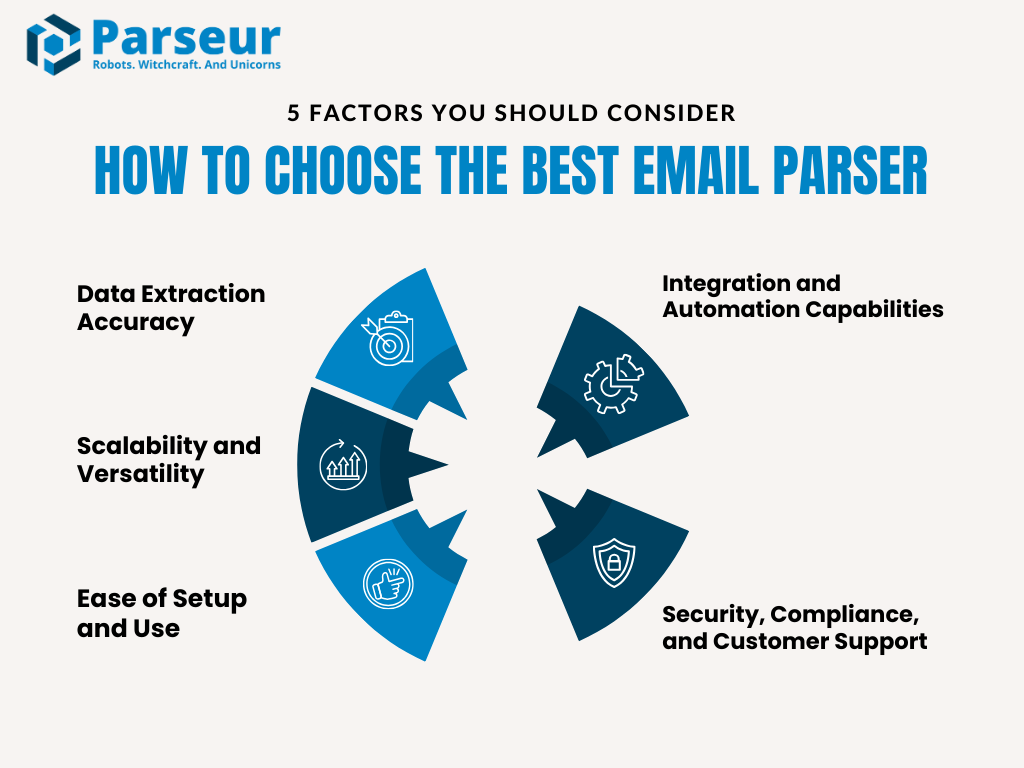Key Takeaways:
- Accuracy, ease of use, and automation are critical when choosing an email parser.
- The best tools integrate seamlessly with your tech stack and require minimal setup.
- Scalability, compliance and security ensure long-term reliability as your business grows.
- Parseur offers AI-powered parsing, integrations, and GDPR-compliant security.
With so many email parser available on the market, each offering different features, pricing models, and levels of complexity, choosing the right one for your specific needs can quickly become overwhelming. Many users are stuck trying to compare countless options without a clear idea of what matters for their business. If you’re feeling this way, you’re not alone.
Choosing the best email extractor is not just about going for the most popular tool or the one that promises the broadest range of integrations. Instead, it’s about understanding your unique requirements and ensuring the selected tool consistently delivers accurate, reliable data extraction. This is especially important as your business grows and the volume and variety of emails increase, which can often complicate parsing efforts if the tool isn’t flexible or scalable enough.
An effective email parser should fit smoothly into your existing workflow and technology stack, be easy to set up and maintain without needing constant technical support, and adapt as your needs evolve. Choosing the wrong tool can lead to wasted time, costly errors, and frustration.
One key statistic from Archive Market Research about the email parsing software market is that its global market size in 2025 is estimated at around $2 billion, with a compound annual growth rate (CAGR) of 15% projected from 2025 to 2033.
Instead of overwhelming you with a list of products, this guide will walk you through five critical factors to consider when evaluating email parsers. These factors will help you focus on what matters and ensure you confidently make an informed decision. Once you understand these essentials, we’ll also explain how Parseur performs in each area, giving you a practical example of what to look for in a high-quality email parsing solution.

1. Data Extraction Accuracy
Accuracy is the foundation of any effective email extractor. If the tool frequently extracts incorrect data or misses essential fields, it can create more problems than it solves. Mistakes in data extraction can lead to errors in decision-making, reporting, and overall workflow, which affect productivity and customer experience.
A reliable email parser should be able to handle variations in email formats and layouts without losing accuracy. It must correctly identify and extract relevant information regardless of inconsistent spacing, different date formats, or unexpected text elements. Consistent precision is key to reducing manual corrections and maintaining smooth operations.
Another important feature is the parser’s ability to flag missing or malformed data. This lets you catch and fix errors before incorrect data spreads through your systems. Testing the tool with your emails is crucial to ensure it meets your accuracy needs in real-world scenarios.
According to Gartner, poor data quality costs organizations an average of $12.9 million annually, underscoring the importance of accurate data extraction in minimizing financial losses and operational inefficiencies.
What to consider:
- AI or ML-enhanced parsing for higher accuracy
- Smart validation or error alerts
- Consistently high accuracy across varying formats
Why it matters: Clean, accurate data saves time and builds trust in your automation.
How Parseur helps: Parseur uses a strong AI engine that adapts to different email formats, minimizing missed fields and manual corrections.
2. Integration and Automation Capabilities
Extracting data from emails is only the first step. Once you have the data, it needs to be moved seamlessly into the right system, whether a CRM, database, spreadsheet, or another platform your team uses daily. Without smooth data transfer, the benefits of automation quickly diminish, and manual work can creep back in.
The best email parsers offer strong integration options to make this process effortless. They typically provide native connectors to popular tools and APIs that allow custom connections to your existing software. Additionally, support for no-technical-knowledge-required automation platforms like Zapier or Make enables you to build workflows without writing a single line of code, making it accessible to non-technical users.
These integration and automation capabilities ensure data flows automatically and reliably to the right place, reducing errors and freeing your team to focus on higher-value tasks. When evaluating an email extractor, consider how well it fits your current tech stack and whether it can grow with your evolving business needs.
What to consider:
- Native integrations with business platforms
- Webhook or API access for flexibility
- End-to-end automation without manual steps
Why it matters: Seamless integrations prevent bottlenecks and reduce errors.
How Parseur helps: Parseur connects with thousands of platforms via Zapier, Make, Power Automate and offers webhooks for full workflow automation.
3. Ease of Setup and Use
No matter how powerful an email parser is, it won’t be effective if it’s challenging to set up or use. Many teams don’t have the time or technical expertise to learn complex tools, so a user-friendly interface is essential. Look for parsers that offer a clean, intuitive design where you can easily navigate the setup process without confusion.
Good email parsers also provide guided onboarding or tutorials that walk users through the initial steps. This kind of support helps new users get started quickly and reduces the learning curve. Additionally, customization options that do not require technical knowledge are a big plus because they let users tailor data extraction to their specific needs without writing complicated rules or code.
The ideal email parser lets you upload an email and start processing emails immediately. This straightforward approach saves time, minimizes errors, and empowers anyone on your team to manage data extraction independently.
What to consider:
- Visual, beginner-friendly editor
- AI-powered field detection
- Helpful onboarding and documentation
Why it matters: A user-friendly tool speeds adoption and reduces IT dependency.
How Parseur helps: With its point-and-click interface, Parseur simplifies setup with no rule-building required.
4. Scalability and Versatility
As your business grows, the demands on your email parser will increase, so it's important to choose a tool that can scale alongside you. This means it can handle a growing volume of emails efficiently without slowing down or missing data. A parser that struggles when volumes rise can create bottlenecks that affect your workflow and overall productivity.
In addition to handling larger volumes, your parser must adapt to changing email formats. Emails rarely stay the same; different senders or new types of messages can all affect how data is structured. A versatile parser should be flexible enough to adjust to these variations without requiring constant manual reconfiguration.
Service availability is another vital consideration. Your email parser must remain accessible at all times, especially if your business handles large volumes of data. Any downtime or interruption can lead to critical data being missed, directly impacting operations. Parseur provides industry-leading service availability with up to 99.99% uptime, as detailed on our status page. Furthermore, Parseur employs robust retry mechanisms to guarantee that no data is lost, even if a service experiences temporary disruptions, thus maintaining continuous and reliable data extraction.
Finally, consider whether the tool can parse beyond just the plain email body. The best parsers will support extracting data from these varied sources, so you’re not limited to just one input type and can get the complete picture every time.
What to consider:
- High throughput for growing email volume
- Parsing support for different formats and languages
- Ability to extract data from files like PDFs and images
Why it matters: A flexible, scalable parser saves you from switching tools later.
How Parseur helps: Built to handle thousands of emails daily, Parseur also parses data from PDFs, Excel files, and images.
5. Security, Compliance, and Customer Support
Security becomes a critical priority when your email parser handles sensitive data such as personal information, financial records, or confidential business details. Choosing a tool that offers strong protections like end-to-end encryption helps to keep your data safe from interception or unauthorized access. Additionally, compliance with regulations such as GDPR or HIPAA is important to ensure your business meets legal standards and avoids costly penalties.
Beyond just technical security, transparent data practices are vital. You want to know where your data is stored, how it is processed, and who can access it. A trustworthy email parsing tool will communicate these policies and guarantee that your data will not be sold or shared without your consent. This builds confidence that your sensitive information is handled responsibly.
Customer support also plays a significant role in your overall experience with an email parser. Issues can happen anytime, and when they do, having quick, knowledgeable, and responsive support can keep your operations running smoothly. Whether you encounter setup challenges, data extraction errors, or integration problems, reliable support can minimize downtime and help you get back on track faster.
A Forbes survey found that 83% of companies with CEOs directly involved in customer experience initiatives reported increased customer satisfaction, and 58% saw increased revenue, highlighting the importance of strong customer support in driving business success.
What to consider:
- Industry-standard encryption and security
- Compliance with laws like GDPR
- Responsive, expert support team
Why it matters: Peace of mind and dependable service are priceless.
How Parseur helps: Parseur is GDPR-compliant and built on secure infrastructure. Its help center and support team are consistently praised for their responsiveness.
Conclusion
Choosing the right email parser is more than picking the most popular or feature-rich option. It requires careful consideration of several key factors that will impact how well the tool fits into your daily operations. Accuracy in data extraction ensures you’re working with reliable information, while seamless integration with your existing systems saves you time and reduces manual effort. Ease of use means you can get up and running quickly without a steep learning curve, making your team more productive from day one.
As your business grows, scalability becomes increasingly important. A good parser must handle larger volumes of emails and adapt to new formats or data types without requiring constant troubleshooting or costly upgrades. At the same time, security and compliance can’t be overlooked, especially when sensitive data is involved. Ensuring your chosen tool follows industry best practices for data protection and offers dependable customer support will give you peace of mind and reduce risks.
Keep this five-factor checklist in mind as you evaluate different email parsing solutions. By focusing on these core areas: accuracy, integration, usability, scalability, and security, you can confidently select a tool that not only meets your current needs but also supports your business as it evolves.
According to a McKinsey report, knowledge workers spend nearly 20-35% of their time searching and gathering information. The right email sorter can help reduce this wasted time by enhancing workflows, improving data quality, and freeing up valuable time to focus on what matters.
Try Parseur: The Email Parser That Checks All the Boxes
If you want a tool that balances accuracy, automation, and ease of use, Parseur is worth a closer look.
With powerful AI, 1000+ integrations, and reliable support, it’s built for businesses that want to stop copy-pasting and start scaling.
Last updated on




